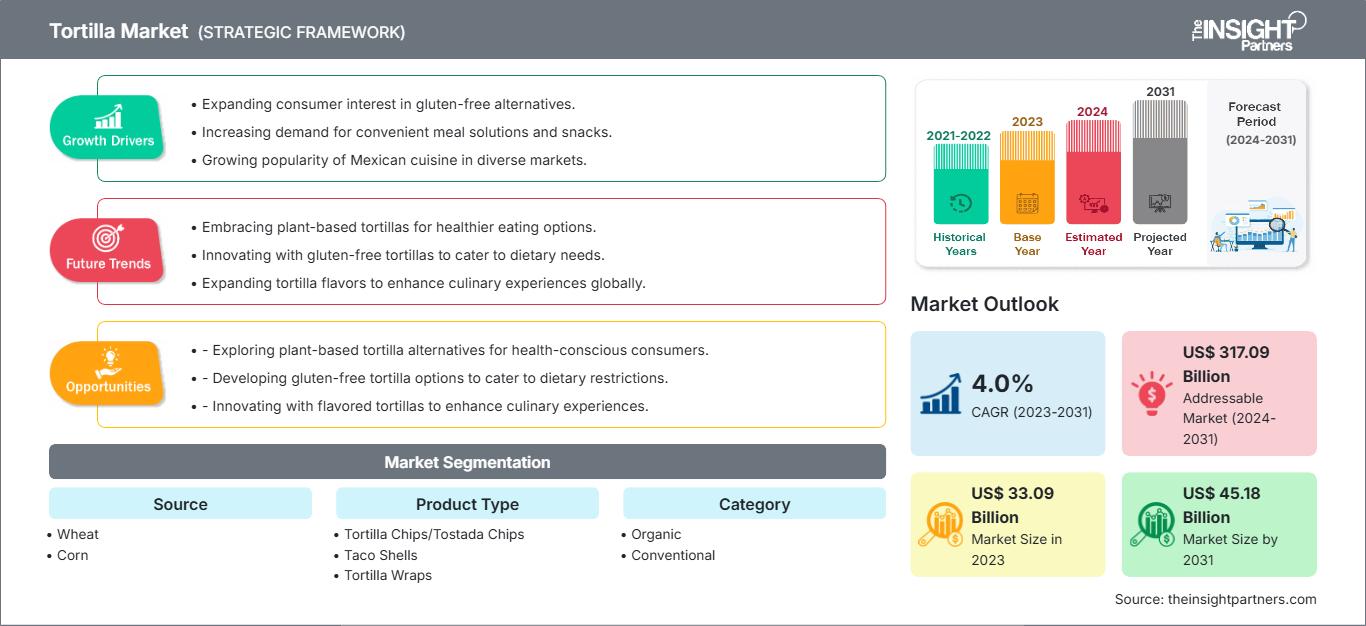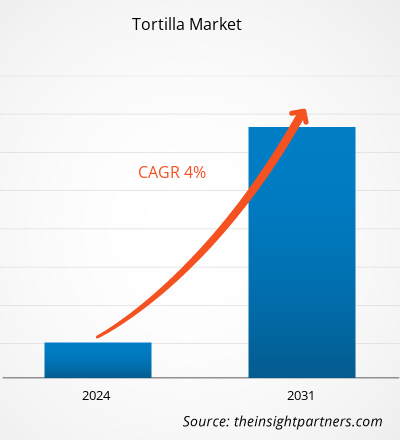预计玉米饼市场规模将从 2023 年的 330.9 亿美元增长到 2031 年的 451.8 亿美元;预计 2023 年至 2031 年的复合年增长率为 4.0%。对有机食品和清洁标签食品的需求激增,很可能成为未来几年玉米饼市场的主要趋势。
玉米饼市场分析
为了预防慢性肺病、糖尿病、心脏病、肥胖症和代谢综合征等健康问题,人们越来越多地消费健康食品,这刺激了对玉米饼等无麸质食品的需求。无麸质玉米饼由米粉、玉米粉或木薯粉制成。许多人尝试新的饮食方式,例如生酮饮食或原始人饮食。此外,人们由于现有的医疗状况而采用无麸质饮食。此外,为了满足消费者日益增长的需求,制造商正专注于开发和推出无麸质产品。例如,2021年,Mission Foods推出了两种更健康的玉米饼产品——杏仁粉玉米饼和花椰菜玉米饼。这两种玉米饼均经过认证,不含麸质,适合纯素食者食用。因此,预计在预测期内,人们对无麸质产品的偏好将为玉米饼市场创造巨大的机遇。玉米饼市场概况
玉米饼是一种圆形、薄的扁平面包,由玉米、小麦或其他谷物制成。杂粮玉米饼由玉米、小麦、大米和扁豆等谷物混合制成。随着消费者越来越注重健康,并寻求从所消费产品中获得健康益处,对杂粮玉米饼、蔬菜玉米饼和无麸质玉米饼的需求正在增长。蓝玉米正成为制作玉米饼的热门原料,因为它蛋白质含量高,淀粉含量低于普通玉米。此外,蓝玉米饼的血糖指数较低,不会导致血糖水平突然飙升。所有这些因素都推动了蓝玉米饼产品的需求,从而推动了玉米饼市场的增长。自定义此报告以满足您的要求
您将免费获得任何报告的定制,包括本报告的部分内容,或国家级分析、Excel 数据包,以及为初创企业和大学提供超值优惠和折扣
玉米饼市场: 战略洞察

-
获取本报告的主要市场趋势。这个免费样本将包括数据分析,从市场趋势到估计和预测。
玉米饼市场的驱动因素和机遇
主要市场参与者的战略举措推动市场增长
玉米饼制造商正在采取多项战略举措,包括推出新产品、扩大生产能力、并购和合作,以提升其市场地位并满足全球客户日益增长的需求。例如,2024 年 1 月,Hain Celestial 旗下品牌 Garden Veggie Snacks 推出了 Flavor Burst Nacho Cheese 和 Zesty Ranch 风味玉米饼片。这些玉米饼片经过认证为无麸质,融合了菠菜、甜菜、红甜椒、胡萝卜和番茄等蔬菜的风味和营养。消费者日益增强的健康意识推动了对此类具有各种健康宣称的玉米饼产品的需求,并促使制造商推出具有创新口味的产品。此外,2021年3月,百事公司Hive加速器旗下的Hilo Life公司推出了一款以杏仁粉为基础的玉米片,目标客户是注重生酮饮食和碳水化合物摄入的消费者。这款玉米片由脱脂杏仁粉制成,比传统杏仁粉含有更多蛋白质,且脂肪含量不增加。此外,玉米片制造商正在多个国家拓展业务。Poco Loco和Santa Maria的母公司Paulig于2022年9月在比利时开设了一家新的玉米片工厂,以满足欧洲对Tex Mex产品日益增长的需求。
预测期内,消费者对无麸质产品的偏好日益增加,为玉米片市场创造机遇
全球不同国家的乳糜泻患病率正在上升。根据《乳糜泻流行病学、表现和诊断》(Epidemiology, Presentation, and Diagnosis of Celiac Disease)2021年发布的数据,乳糜泻病例遍布全球,这与此前认为该病主要发生在西欧和北欧的观点相悖。乳糜泻可能导致甲状腺/1型糖尿病,或损害部分患者的肠道内壁。《超越乳糜泻》(Beyond Celiac)的数据显示,估计每133个美国人中就有1人(约占总人口的1%)患有乳糜泻。在美国,最近的筛查研究表明乳糜泻的患病率可能高于1%。无麸质饮食可以通过促进肠道愈合来减轻乳糜泻的影响。因此,消费者普遍偏爱无麸质饮食。为了顺应这种偏好的转变,玉米饼制造商也在开发无麸质产品,以满足日益增长的需求。因此,预计在预测期内,对无麸质产品的偏好日益增长将为玉米饼市场创造巨大的机遇。越来越多注重健康且未被确诊患有麸质过敏症的消费者也开始采用无麸质饮食,将其作为更广泛的健康生活方式的一部分。这一趋势推动了玉米饼领域的创新,鼓励制造商通过玉米、杏仁、木薯和鹰嘴豆等替代面粉来丰富其产品组合。这些无麸质配方不仅迎合了饮食限制,也吸引了寻求新口感和营养价值的消费者。
零售商正在扩大无麸质产品的货架空间,这表明市场接受度越来越高,商业可行性也越来越高。随着餐饮服务提供商和快餐店 (QSR) 越来越多地将无麸质玉米饼添加到菜单中,这开辟了新的收入来源并深化了市场渗透率。
玉米饼市场报告细分分析
有助于得出玉米饼市场分析的关键细分是来源、产品类型、类别和分销渠道。- 根据来源,玉米饼市场分为玉米、小麦和其他。玉米部分在 2023 年占据了最大的市场份额。
- 按产品类型,市场分为玉米饼/烤玉米饼片、玉米卷饼、玉米饼卷和其他。玉米饼/烤玉米饼片在 2023 年占据了最大的市场份额。
- 根据类别,玉米饼市场分为有机和传统两类。预计有机部分在 2023 年至 2031 年期间的复合年增长率更高。
- 在分销渠道方面,市场分为超市和大卖场、便利店、在线零售和其他。超市和大卖场在 2023 年占据了相当大的市场份额。
按地区划分的玉米饼市场份额分析
玉米饼市场报告的地理范围主要分为五个区域:北美、亚太地区、欧洲、中东和非洲以及南美和中美。2023 年,北美占据了玉米饼市场的主导地位,而亚太地区预计在 2023 年至 2031 年期间的复合年增长率最高。澳大利亚是亚太地区增长最快的玉米饼市场之一。在澳大利亚,玉米饼的受欢迎程度受到其在各种零售渠道(包括传统杂货店、大卖场、便利店和在线零售)供应增加的影响。消费者追求便利,制造商不断推出新的产品种类、风味、更健康的替代品以及无麸质和植物性选择,以满足不同的烹饪需求和偏好,吸引寻求快餐或零食的消费者。例如,2023年10月,多力多滋推出了新口味——芫荽。芫荽口味据称香气扑鼻,带有浓郁的皂感,带来大胆而独特的味觉体验。与澳大利亚一样,日本的玉米饼市场预计也将在2023年至2031年间实现显著增长。玉米饼在日本日益流行,这得益于日本和墨西哥烹饪风格的融合,以及便利店的创新产品。随着日本消费者对融合美食的兴趣日益浓厚,日本的烹饪界正呈现出一股令人着迷的趋势。人们越来越倾向于将传统的日本寿司文化与拉丁美洲主食,尤其是墨西哥菜肴相融合。这种烹饪融合对日本的玉米饼行业产生了积极影响,使其销量大幅增长。日本的便利店正在引领新的食品潮流,日本7-11便利店和全家便利店等主要连锁店推出了墨西哥卷饼等限量版产品。这些小举措让日本消费者熟悉了墨西哥美食,并推动了日本市场的流行趋势。
玉米饼市场区域洞察
Insight Partners 的分析师已详尽阐述了预测期内影响玉米饼市场的区域趋势和因素。本节还讨论了北美、欧洲、亚太地区、中东和非洲以及南美和中美洲的玉米饼市场细分和地域分布。
玉米饼市场
The Insight Partners 的分析师已详尽阐述了预测期内影响玉米饼市场的区域趋势和因素。本节还讨论了北美、欧洲、亚太地区、中东和非洲以及南美和中美洲的玉米饼市场细分和地域分布。
玉米饼市场报告范围
| 报告属性 | 细节 |
|---|---|
| 市场规模 2023 | US$ 33.09 Billion |
| 市场规模 2031 | US$ 45.18 Billion |
| 全球复合年增长率 (2023 - 2031) | 4.0% |
| 历史数据 | 2021-2022 |
| 预测期 | 2024-2031 |
| 涵盖的领域 |
By 来源
|
| 覆盖地区和国家 |
北美
|
| 市场领导者和主要公司简介 |
|
玉米饼市场参与者密度:了解其对商业动态的影响
玉米饼市场正在快速增长,这得益于终端用户需求的不断增长,而这些需求的驱动因素包括消费者偏好的演变、技术进步以及对产品优势的认知度不断提高。随着需求的增长,企业正在扩展产品线,不断创新以满足消费者需求,并抓住新兴趋势,从而进一步推动市场增长。

- 获取 玉米饼市场 主要参与者概述
玉米饼市场新闻及近期发展
玉米饼市场评估通过收集一手和二手资料后的定性和定量数据进行,这些数据包括重要的企业出版物、协会数据和数据库。玉米饼市场近期的一个关键发展如下:- Paulig 收购了西班牙公司 Liven,以增强其在欧洲的德州墨西哥风味和零食业务。 (来源:公司网站,2022 年 1 月)
玉米饼市场报告覆盖范围和可交付成果
《玉米饼市场规模和预测(2021-2031)》报告对市场进行了详细的分析,涵盖以下领域:
- 涵盖范围内所有主要细分市场的全球、区域和国家/地区层面的玉米饼市场规模和预测
- 玉米饼市场趋势以及市场动态,例如驱动因素、限制因素和关键机遇
- 详细的波特五力模型和 SWOT 分析
- 玉米饼市场分析涵盖主要市场趋势、全球和区域框架、主要参与者、法规和最新市场发展
- 行业格局和竞争分析涵盖市场集中度、热图分析、知名参与者和玉米饼市场的最新发展
- 详细的公司简介
- 历史分析(2 年)、基准年、预测(7 年)及复合年增长率
- PEST和SWOT分析
- 市场规模、价值/数量 - 全球、区域、国家
- 行业和竞争格局
- Excel 数据集
近期报告
客户评价
购买理由
- 明智的决策
- 了解市场动态
- 竞争分析
- 客户洞察
- 市场预测
- 风险规避
- 战略规划
- 投资论证
- 识别新兴市场
- 优化营销策略
- 提升运营效率
- 顺应监管趋势






















 获取免费样品 - 玉米饼市场
获取免费样品 - 玉米饼市场